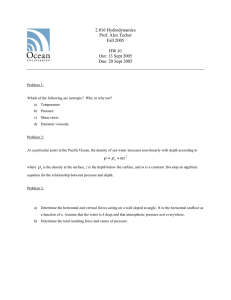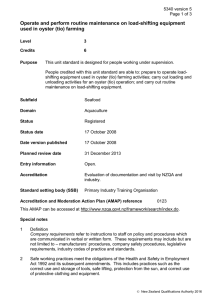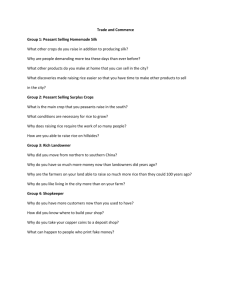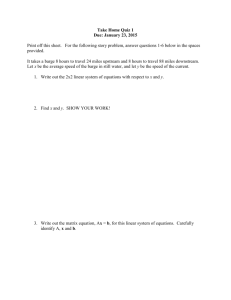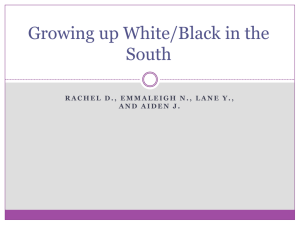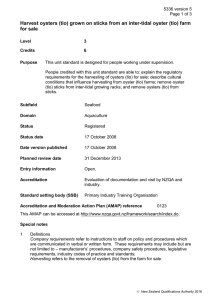Operate an oyster (tio) barge on inner harbour limits
advertisement
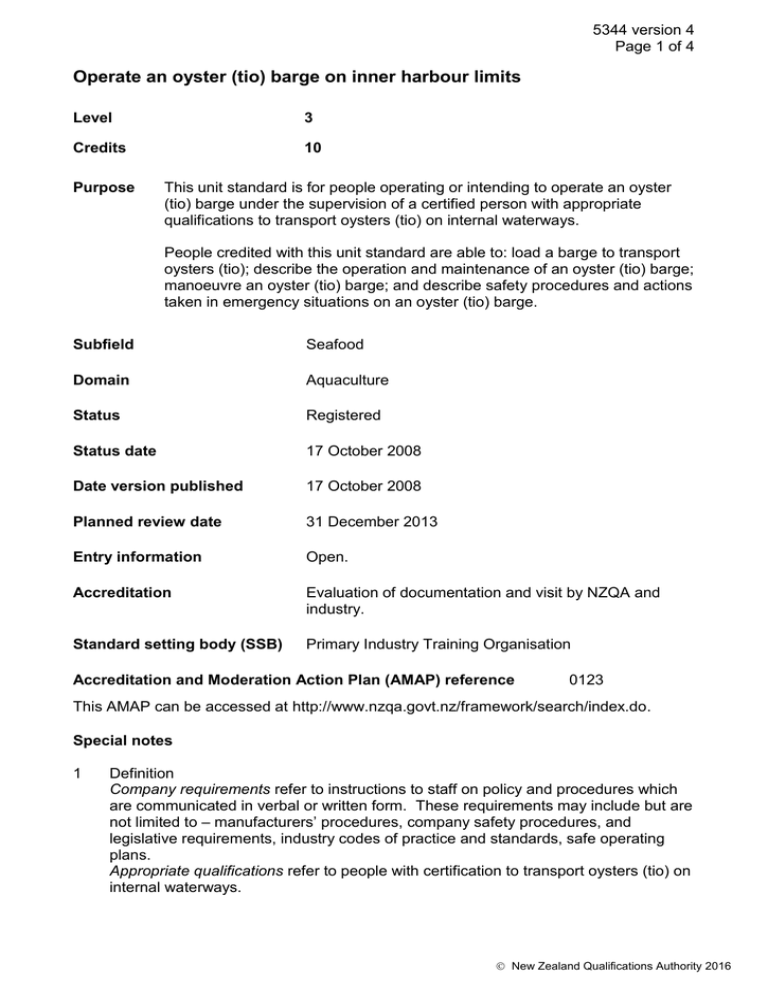
5344 version 4 Page 1 of 4 Operate an oyster (tio) barge on inner harbour limits Level 3 Credits 10 Purpose This unit standard is for people operating or intending to operate an oyster (tio) barge under the supervision of a certified person with appropriate qualifications to transport oysters (tio) on internal waterways. People credited with this unit standard are able to: load a barge to transport oysters (tio); describe the operation and maintenance of an oyster (tio) barge; manoeuvre an oyster (tio) barge; and describe safety procedures and actions taken in emergency situations on an oyster (tio) barge. Subfield Seafood Domain Aquaculture Status Registered Status date 17 October 2008 Date version published 17 October 2008 Planned review date 31 December 2013 Entry information Open. Accreditation Evaluation of documentation and visit by NZQA and industry. Standard setting body (SSB) Primary Industry Training Organisation Accreditation and Moderation Action Plan (AMAP) reference 0123 This AMAP can be accessed at http://www.nzqa.govt.nz/framework/search/index.do. Special notes 1 Definition Company requirements refer to instructions to staff on policy and procedures which are communicated in verbal or written form. These requirements may include but are not limited to – manufacturers’ procedures, company safety procedures, and legislative requirements, industry codes of practice and standards, safe operating plans. Appropriate qualifications refer to people with certification to transport oysters (tio) on internal waterways. New Zealand Qualifications Authority 2016 5344 version 4 Page 2 of 4 2 Safe working practices meet the obligations of the Health and Safety in Employment Act 1992 and its subsequent amendments. This includes practices such as the correct use and storage of tools, safe lifting, protection from the sun, correct use of protective clothing and equipment. 3 Regulatory requirements include but are not limited to – the Animal Products Act 1999. Elements and performance criteria Element 1 Load a barge to transport oysters (tio). Performance criteria 1.1 Weight of load does not exceed the company requirements with respect to safe limits for the vessel for the weather conditions. Range 1.2 The load is distributed safely and securely according to company requirements. Range 1.3 current and forecasted weather conditions. stability, visibility, trim. Stowage of oysters (tio) meets regulatory requirements with regard to shellfish sanitation and avoiding cross contamination. Element 2 Describe the operation and maintenance of an oyster (tio) barge. Performance criteria 2.1 The description includes how the fuel is stowed in accordance with company requirements. 2.2 The description includes the safe operating procedures in accordance with company requirements. 2.3 Any abnormal function of the oyster (tio) barge is identified, and action to take described according to company requirements. 2.4 The description includes the maintenance requirements of the oyster (tio) barge in accordance with company requirements. 2.5 The description includes the documentation requirements in accordance with company requirements. New Zealand Qualifications Authority 2016 5344 version 4 Page 3 of 4 Element 3 Manoeuvre an oyster (tio) barge. Performance criteria 3.1 The barge is manoeuvred in accordance with legislative requirements, and in a manner that maintains the safety of the craft, its passengers, and load. 3.2 The course taken to the destination allows for the effect of the tide and weather conditions, and avoids identified hazards. 3.3 The barge is manoeuvred between the rows of an oyster (tio) farm by moving ahead and moving astern without damage to the rows, sticks, grow-out units, or barge. 3.4 The barge is secured between oyster (tio) racks, in open water, and at overnight anchorage, without causing damage to the barge or other structures or vessels. Range 3.5 mooring, anchor, ‘spud’ poles. Evidence is required for one method of securing the barge in each location. Towing of other vessels is undertaken using towlines and fittings without damage to vessels, equipment, or structures and in accordance with legislative requirements. Element 4 Describe safety procedures and actions taken in emergency situations on an oyster (tio) barge. Performance criteria 4.1 The description includes the safety equipment required on the oyster (tio) barge. Range 4.2 The description includes actions required to maintain the safety of personnel and the barge in emergency situations. Range 4.3 storage, maintenance. fire, ‘man overboard’, hypothermia, equipment breakdown, capsize, collision, hull damage, grounding. The description includes distress-signalling techniques that meet the requirements and limitations of the emergency situation and equipment on board the barge. Range hand signals, telephone, flares. New Zealand Qualifications Authority 2016 5344 version 4 Page 4 of 4 4.4 The description includes the actions to be taken and the reporting procedures after an accident has occurred. 4.5 The description includes the responses to distress situations occurring on other craft that are appropriate to the capabilities of the barge, its equipment, and the personnel on board. Please note Providers must be accredited by NZQA, or an inter-institutional body with delegated authority for quality assurance, before they can report credits from assessment against unit standards or deliver courses of study leading to that assessment. Industry Training Organisations must be accredited by NZQA before they can register credits from assessment against unit standards. Accredited providers and Industry Training Organisations assessing against unit standards must engage with the moderation system that applies to those standards. Accreditation requirements and an outline of the moderation system that applies to this standard are outlined in the Accreditation and Moderation Action Plan (AMAP). The AMAP also includes useful information about special requirements for organisations wishing to develop education and training programmes, such as minimum qualifications for tutors and assessors, and special resource requirements. Comments on this unit standard Please contact the Primary Industry Training Organisation standards@primaryito.ac.nz if you wish to suggest changes to the content of this unit standard. New Zealand Qualifications Authority 2016
